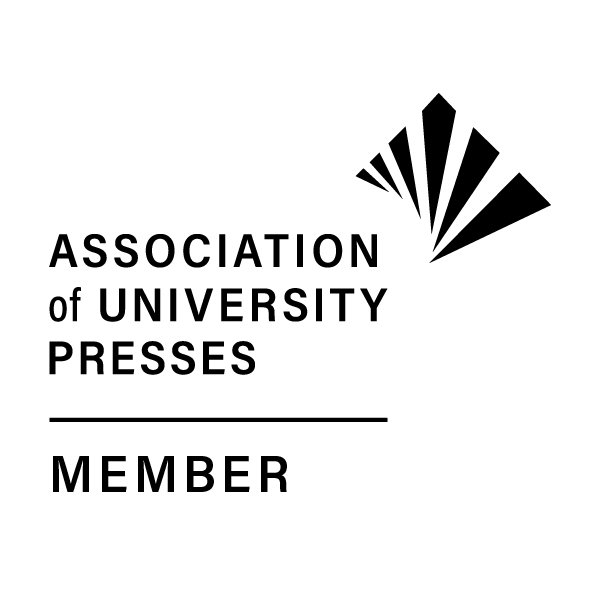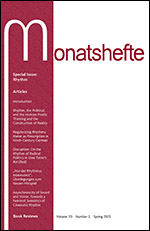|


|

Subscribe
Read the Journal Online
Submission Guidelines
Editorial Board
Receive Email Updates
Advertise in Monatshefte
Indexes/Abstracts
Current Issue TOC
Back Issues TOC
Monatshefte 2022 Subscription Rates
Institutions:
print & online $271
online only $233
Individuals:
print & online $103
online only $86
Non U.S. Postage (no postage charges for online-only subscriptions)
Airmail: add $40/yr.
Canadian Subscribers: add 5% GST. |
Monatshefte
Volume 113, Number 3, Fall 2021
Table of Contents
Special Issue: Annemarie Schwarzenbach's Photographic Practice
ARTICLES
Svea Braeunert and Tanja Nusser
Introduction: Annemarie Schwarzenbach’s Photographic Practice
Moritz Wagner
„Einmal an der Quelle sein“. Annemarie Schwarzenbachs Reisefotografien 1933–1942 online
On the occasion of Annemarie Schwarzenbach’s 100th birthday, in 2008, the Swiss Literary Archive, which collects her literary and photographic estate, launched a virtual exhibition in the form of an interactive Flash app. For the first time, 100 of her photographs were available online. Since its initial publication in 2008, the app has undergone a fundamental update. Today, nearly all of Schwarzenbach’s 3,500 travel photographs are mapped, interactively linked, and searchable through the online application. Presenting the design and function of the app, the essay homes in on the possibilities of digital archives and the methods afforded by digital humanities. It highlights the network structure of the app and the way it allows for an interactive treatment of the photographs, which, in turn, can have an effect on the different orders and readings of the archive. Taking the particularities of Schwarzenbach’s archival holdings seriously, which include photographs as well as texts, the essay takes the recent donation of 40 letters as its cue to discuss the relationship between text and image, suggesting to further bring the two together in the design of future digital platforms devoted to literary-visual research. (MW; in German)
Christina Natlacen
„Als Zuschauer geduldet an der Schwelle“. Fotografische Porträts aus Vorderasien und Afghanistan von Annemarie Schwarzenbach
During her trips to Turkey, Afghanistan, and Iraq between 1933 and 1940, Annemarie Schwarzenbach created landscape and architectural photographs as well as numerous photographic portraits of the local population, assembling visual material for her photo reports and travel books. This article analyzes the different ways in which Schwarzenbach approached her subjects by examining unpublished photographs in the estate of the Swiss Literary Archive and by considering written sources. The portraits range from fleeting shots seemingly made without the consent of the depicted, portraits modelled on orientalist-type shots, images suggesting a consensus between photographer and photographed, and instances in which she as a photographer makes herself invisible. A development thus becomes visible in Schwarzenbach’s photographic work, which one can describe as a gradual stepping back on the part of the photographer to give the people in front of the camera greater space and more autonomy. (CN; in German)
Elisaveta Dvorakk
Annemarie Schwarzenbachs Straßenszene in Moskau 1934. Antifaschistische Bildästhetik zwischen fotografischem Konstruktivismus und sozialistischem Realismus
Looking closely at two photographs from Annemarie Schwarzenbach’s journey to Moscow in 1934, during which she attended the First General Assembly of Soviet Writers together with Klaus Mann, this article follows a two-pronged argument. First, it investigates the impact the rivaling styles of Soviet constructivism and Socialist realism had on Schwarzenbach’s photographic aesthetic, suggesting that her understanding of photography as a form of social engagement and critique preceded her trip to the United States and her encounter with the photographic program of the Farm Security Administration in 1937. Second, the article borrows the image studies’ concept “Bildträger” (the base or support of an image, or literally that which carries the image) from Gottfried Boehm and suggests it as a crucial method for approaching Schwarzenbach’s photographic practice. Bildträger are those archival materials which are not photographs themselves but carry information for understanding content and context of an image, including letterheads, envelopes, and hand-written notes. Taken together, these two approaches allow for new insights into Schwarzenbach’s photographic œuvre, particularly concerning her trip(s) to the Soviet Union and her political engagement through the medium of documentary photography. (ED; in German)
Christiane Arndt
Die visuelle Ästhetik einer Doppelbelichtung: Annemarie Schwarzenbach, Estland 1937
While traveling in Estonia in 1937, Annemarie Schwarzenbach created a double-exposed photograph which shows both a group of flower sellers and a freight train. The image reflects on industrialisation and the juxtaposition of farm and urban life in the Baltic country. The aesthetic composition of the photo brings about a poetic aspect as a result of camera technology. Incorporating technology in its means of artistic expression, the view on Estonian society that reveals the shift of industrialization is thus made visible through aesthetics that Lásló Moholy-Nagy describes in the context of New Vision. Schwarzenbach identifies a comparable poetic trace in the publication formats she considers ideal, namely large-format images and text-only travel reports. The resulting ambiguity of documentary and fiction is characteristic for the contemporary style of new journalism. (CA; in German)
Kara Charles Felt
Annemarie Schwarzenbach and the Margins of Visibility in the American South
On road trips across the globe, Annemarie Schwarzenbach made photographs illuminating different cultures and giving visibility to marginalized communities. Her time in the U.S. presents a uniquely rewarding focus for a reassessment of her photographic practice. She worked there during the pinnacle of American documentary photography, producing photographs and reports during three visits to the Eastern U.S. between September 1936 and February 1941. My article investigates the unexplored connections between her American photographs and images created by photographers working for the Farm Security Administration, especially regarding issues of race and class. I focus on a photograph Schwarzenbach made in Knoxville, Tennessee in 1937 and draw on Édouard Glissant’s theory of opacity to explore how she wielded perceptual instability to preserve her subjects’ agency. By placing Schwarzenbach within a network of photographers, I ultimately seek to clarify her position among socially conscious image-makers in the 1930s. (KCF)
Verena R. Kick
Shifting Constellations—Shifting Narratives? Issues of Intersectionality in Annemarie Schwarzenbach’s Photography from the U.S. South
The article takes a photo by Annemarie Schwarzenbach, depicting Black and white children in Savannah, GA, as a starting point to examine the ways in which its internal discourse of race, labor, and gender shifts when it is compared to its external discourse, informed by the photo’s various publication contexts. For instance, in the Swiss Literary Archive’s folder, the photo’s Black children are mirrored by the succeeding photo’s white vagrants. In contrast, in a digital visualization of Schwarzenbach’s journeys, the key image is juxtaposed with a photo of white farmers. In both contexts the intersectionality of race, labor, and gender is foregrounded, which corresponds to the photo’s original external discourse in Savannah where Schwarzenbach documented racial segregation. The argument unfolds how changing publication contexts reinforce a photo’s intersectional narrative, while also revealing Schwarzenbach’s elaborate understanding of the intersection of race, labor, and gender in her photographs of the U.S. South. (VK).
BOOK REVIEWS
Althaus, Thomas, Hrsg., Darstellungsoptik. Bild-Erfassung und Bilderfülle in der Prosa des 19. Jahrhunderts (Rüdiger Singer)
Bauer, Matthias, Harald Hohnsbehn und Iulia-Karin Patrut, Fontane und die Realisten. Weltgehalt und Eigensinn (Christian Thomas)
Beck, Andreas, Nicht alles glauben, was geschrieben steht! Wie frühe illustrierte Journale (nicht) über sich Auskunft geben. Pfennig-Magazin zur Journalliteratur. Heft 5 (Moritz Baßler)
Becker-Cantarino, Barbara, Hrsg., Bettina von Arnim Handbuch (Helen G. Morris-Keitel)
Blasberg, Cornelia und Jochen Grywatsch, Hrsg., Annette von Droste-Hülshoff Handbuch (Vance Byrd)
Döring, Moritz, Grenzen überschreiten. Rezipienten-, Text-, Format- und Variantenwanderungen im Taschenbuch zum geselligen Vergnügen auf das Jahr 1823. Pfennig-Magazin zur Journalliteratur. Heft 3 (Moritz Baßler)
Garloff, Katja and Agnes Mueller, eds., German Jewish Literature after 1990 (Cathy S. Gelbin)
Gretz, Daniela, Marcus Krause, James Mussell, and Nicolas Pethes, Media (B)Orders. Between Periodicals and Books. Miscellaneity and Classification in Nineteenth Century Magazines and Literature. Pfennig-Magazin zur Journalliteratur. Heft 4 (Moritz Baßler)
Groves, Jason, The Geological Unconscious: German Literature and the Mineral Imaginary (Helga Braunbeck)
Kaminski, Nicola, „O ja. Entscheiden. Seht doch …“: Der „zerbrochne Krug“ als Fall der Textkritik. Pfennig-Magazin zur Journalliteratur. Heft 6 (Moritz Baßler)
Kaminski, Nicola und Jens Ruchatz, Journalliteratur – ein Avertissement. Pfennig-Magazin zur Journalliteratur. Heft 1 (Moritz Baßler)
Kita, Caroline A., Jewish Difference and the Arts in Vienna: Composing Compassion in Music and Biblical Theatre (Friedrich Voit)
Landgraf, Edgar and Elliott Schreiber, eds., Play in the Age of Goethe: Theories, Narratives, and Practices of Play around 1800 (Joseph D. O’Neil)
Laufer, Almut, Land, Dorf, Kehilla. „Landjudentum” in der deutschen und deutsch-jüdischen Erzählliteratur bis 1918 (Jost Hermand)
Mergenthaler, Volker, Garderobenwechsel. „Das Fräulein von Scuderi“ in Taschenbuch, Lieferungswerk und Journal (1819–1871). Pfennig-Magazin zur Journalliteratur. Heft 2 (Moritz Baßler)
Nagel, Barbara N., Ambiguous Aggression in German Realism and Beyond: Flirtation, Passive Aggression, Domestic Violence (Daniela Richter)
Pahl, Katrin, Sex Changes with Kleist (Bernd Fischer)
Seeba, Hinrich C., Berliner Adressen. Soziale Topographie und urbaner Realismus bei Theodor Fontane, Paul Lindau, Max Kretzer und Georg Hermann (Erhard Schütz)
Sina, Kai und David Wellbery, Hrsg., Goethes Spätwerk / On Late Goethe (Gabrielle Bersier)
Strowick, Elisabeth, Gespenster des Realismus. Zur literarischen Wahrnehmung von Wirklichkeit (Monika Schmitz-Emans)
Tautz, Birgit, Translating the World: Toward a New History of German Literature Around 1800 (Peter Goßens)
Thanner, Veronika, Joseph Vogl und Dorothea Walzer, Hrsg., Die Wirklichkeit des Realismus (Monika Schmitz-Emans)
Wagner, Martin, The Narratology of Observation: Studies in a Technique of European Literary Realism (Peter C. Pfeiffer)
|

